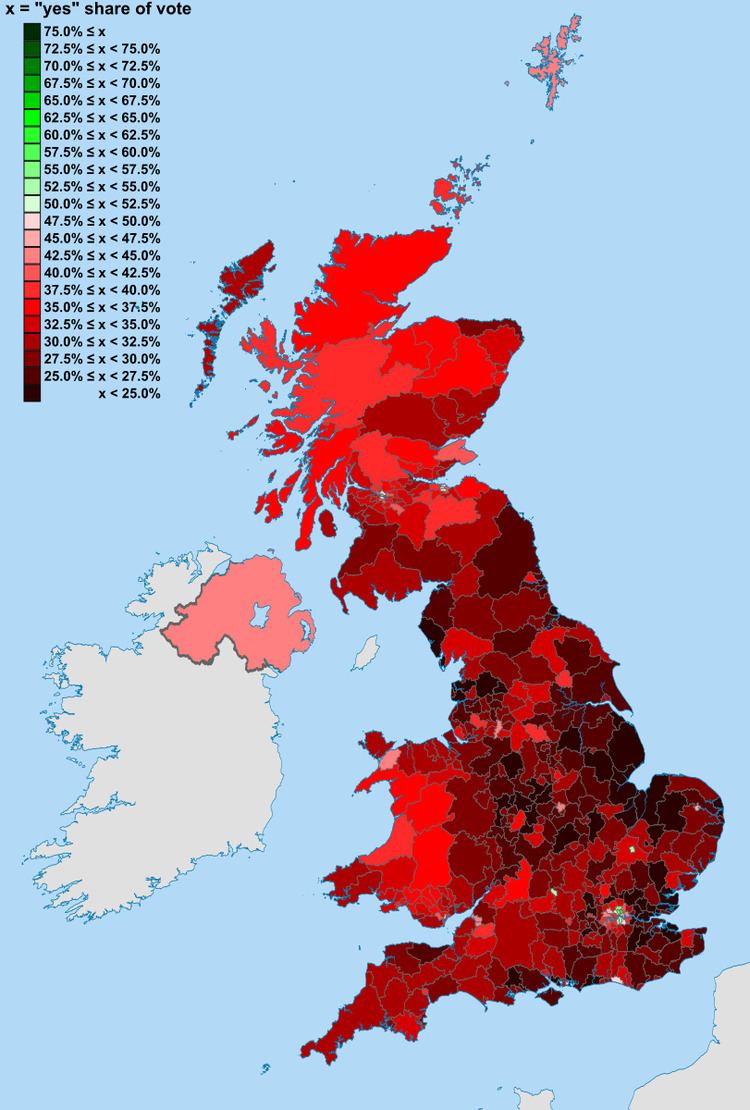Yes 6,152,607 Valid votes 19,165,730 Location United Kingdom | No 13,013,123 Date 5 May 2011 | |
 | ||
6,152,607 7001321000000000000♠32.10% 13,013,123 7001679000000000000♠67.90% 19,165,730 7001994100000000000♠99.41% | ||
In the United Kingdom, the Alternative Vote referendum was a public vote that took place on 5 May 2011, on whether to change the system for electing the House of Commons, the lower house of the national Parliament at Westminster. In the result of a Yes vote, future United Kingdom general elections would have used the "Alternative Vote" (AV); in the event of a No vote, the voting system would remain the same, with the UK continuing to use the "First Past the Post" (FPTP) voting system. The votes cast in the referendum were first counted in each of 440 districts or electoral divisions across the country (the "local counting areas"), which were then combined and declared at a regional level (the regions being the constituent countries of Wales, Scotland and Northern Ireland, and the regions of England).
Contents
- United Kingdom
- Local results
- England
- East Midlands
- East of England
- London
- North East England
- North West England
- South East England
- South West England
- West Midlands
- Yorkshire and the Humber
- Northern Ireland
- Scotland
- Wales
- References
Under the provisions of the Parliamentary Voting System and Constituencies Act 2011 there was a total of 440 counting areas across twelve regions using the same boundaries as used in European Parliamentary elections since 1999 under the provisions of the European Parliamentary Elections Act 2002. In England the 326 local government districts were used as the voting areas; these consist of all unitary authorities, all metropolitan boroughs, all shire districts, the London boroughs, the City of London and the Isles of Scilly. As the date of the plebiscite coincided with elections to the Scottish Parliament, Welsh Assembly and the Northern Ireland Assembly different arrangements were required for the devolved nations so in Scotland the 73 Scottish Parliamentary constituencies were used as the Scottish counting areas and in Wales the 40 Welsh assembly constituencies were used as the Welsh counting areas and Northern Ireland was a single counting area.
Ballots were due to be verified by 1pm on 6 May 2011 and the votes were counted from 4pm onwards. Both the local and regional results were updated live online via aboutmyvote.co.uk, a publicly accessible website run by the Electoral Commission.
This article lists, by counting area, all the results of the referendum, each ordered into national and regional sections.
United Kingdom
The national result for the whole United Kingdom was announced at the Platinum Suite at the Exhibition Centre London (ExCel) by the Chief counting officer (CCO) and Chair of the Electoral Commission, Jenny Watson, at 0100 BST on Saturday 7 May 2011 after all 440 counting areas and UK regions had declared their results. With a national turnout of 42% the target to secure the majority win for the winning side was 9,639,512 votes. The decision by the electorate was a decisive "No" vote to adopting the alternative vote system in all future United Kingdom general elections by a majority of 6,860,516 votes over those who had voted "Yes" in favor of the proposal.
Local results
Of the 440 counting areas, ten returned a majority in favour of the change (Cambridge, Oxford, Glasgow Kelvin, Edinburgh Central, and the London Boroughs of Hackney, Islington, Haringey, Lambeth, Southwark and Camden). The counting area with the highest proportion of AV supporters was the London Borough of Hackney with 60.68% in favour of the change (34.23% turnout) and the lowest proportion was the borough of Castle Point, Essex with 20.29% in favour (41.38% turnout).
England
The districts of England were used as the local counting areas for the UK-wide referendum in England; these consist of all unitary authorities, all metropolitan boroughs, all shire districts, the London boroughs, the City of London and the Isles of Scilly.
The English Regions were also then used to count the votes at the regional level. All nine regions in England returned huge "no" votes.
East Midlands
The East Midlands region was broken down into 40 local counting areas.
East of England
The East of England region was broken down into 47 local counting areas.
London
The London region was broken down into 33 local counting areas.
North East England
The North East England region was broken down into 12 local counting areas.
North West England
The North West England region was broken down into 39 local counting areas.
South East England
The South East England region was broken down into 67 local counting areas.
South West England
The South West England region was broken down into 37 local counting areas.
West Midlands
The West Midlands region was broken down into 30 local counting areas.
Yorkshire and the Humber
The Yorkshire and the Humber region was broken down into 21 local counting areas.
Northern Ireland
Northern Ireland was a single counting area, as well as being a regional count for the UK-wide referendum. It was the last region of the United Kingdom to declare its result after major delays due to slow pace of counting and declaring results for the 2011 Northern Ireland Assembly Elections meant that the start of the local count for the referendum could not begin until the evening on Friday 6 May 2011, several hours after counting had started in the rest of the country and the result was not finally known until 1am on Saturday 7 May 2011.
Scotland
The constituencies of the Scottish Parliament were used as the local counting areas for the UK-wide referendum throughout Scotland.
Scotland was broken down into 73 local counting areas.
Wales
The constituencies of the National Assembly for Wales were used as the local counting areas for the UK-wide referendum throughout Wales.
Wales was broken down into 40 local counting areas.
